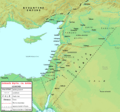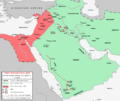Muawiyah I facts for kids
Quick facts for kids Muawiyah I |
|||||
|---|---|---|---|---|---|
| Reign | 661 – 680 | ||||
| Predecessor | unknown | ||||
| Successor | Yazid I | ||||
| Born | 602 | ||||
| Died | May 6, 680 | ||||
|
|||||
| Dynasty | Umayyad | ||||
| Father | Abu Sufyan ibn Harb | ||||
| Mother | Hind bint Utbah | ||||
Muawiyah I (born in 602, died in 680) was an important leader in early Islamic history. He was a relative of Uthman, who was one of the early leaders of the Muslim community. Muawiyah is most famous for starting the Umayyad dynasty, which was a powerful ruling family. He also had a major disagreement with Ali, another important figure at the time.
Contents
Who Was Muawiyah I?
Muawiyah was born in the city of Mecca around the year 602. His full name was Muawiyah ibn Abi Sufyan. His father, Abu Sufyan, was a respected leader in Mecca. His mother was Hind bint Utbah.
Early Life and Conversion to Islam
Muawiyah grew up in Mecca. His family was part of the powerful Quraysh tribe. At first, his family was not Muslim. However, they later accepted Islam. Muawiyah became a Muslim when the city of Mecca was taken by the Muslims.
Serving the Early Caliphs
After becoming Muslim, Muawiyah became a trusted helper. He worked for the early leaders of the Muslim community, known as caliphs. He served under Caliph Abu Bakr and Caliph Umar. These experiences helped him learn a lot about leadership.
Becoming Governor of Syria
Muawiyah was given a very important job. He became the governor of Syria. This happened during the rule of Caliph Umar. Syria was a key region for the growing Muslim empire. Muawiyah proved to be a very skilled governor.
Building Power in Syria
As governor, Muawiyah made Syria strong. He built a loyal army and navy. He also developed the region's economy. His long time as governor helped him gain a lot of support. People in Syria trusted him and looked up to him.
Defending Against the Byzantines
Syria was close to the Byzantine Empire. This empire was a major rival. Muawiyah often led his forces against the Byzantines. He protected the Muslim lands from their attacks. These battles showed his military skills.
The Rise of the Umayyad Dynasty
After the death of Caliph Uthman, a period of conflict began. This period is known as the First Fitna. Muawiyah became a strong leader during this time. He disagreed with Ali, who became the next caliph.
Conflict with Ali
Muawiyah and Ali had different ideas about leadership. This led to a civil war. Their armies met at the Battle of Siffin. After some time, they agreed to talk things over. However, the conflict continued.
Becoming Caliph
Eventually, Muawiyah became the caliph in 661. This marked the start of the Umayyad dynasty. He moved the capital of the empire to Damascus in Syria. This was a big change from earlier capitals.
Governing the Islamic Empire
As caliph, Muawiyah ruled a vast empire. He focused on making the empire stable. He also worked to expand its borders. His reign lasted for almost 20 years.
Expanding the Empire
Under Muawiyah, the empire grew. Muslim armies conquered new lands. They moved into parts of North Africa. This included the region of Ifriqiya. This expansion added more people and resources to the empire.
Muawiyah understood the importance of the sea. He built a powerful navy. This navy helped protect the empire's coasts. It also allowed for naval attacks on the Byzantine Empire. The navy was key to controlling the Mediterranean Sea.
Muawiyah's Legacy
Muawiyah I died in 680. He is remembered as the founder of the Umayyad dynasty. This dynasty ruled for nearly 90 years. He brought stability to the empire after a period of civil war. He also set up many important government systems.
A Strong Administrator
Muawiyah was known for his good organization. He created a strong government. He also made sure that the empire's finances were well managed. His leadership helped the empire grow and prosper.
Succession and the Future
Before he died, Muawiyah named his son, Yazid I, as his successor. This was a new way of choosing a leader. It meant that the caliphate would pass down in the family. This decision had a lasting impact on Islamic history.
Images for kids
-
Map of the First Fitna. The areas shaded in green, namely the regions of Iraq, Arabia, Persia and the Caucasus, and pink, namely the regions of Syria and Egypt, respectively represent the territories under Caliph Ali's and Mu'awiya's control in 658.
-
A Greek inscription crediting Mu'awiya for restoring the Roman-era bath facilities at Hamat Gader in 663, the sole epigraphic attestation of Mu'awiya's rule in Syria, the center of his caliphate
-
Map showing the raids, battles and naval engagements between the Arab Caliphate and Byzantine during Mu'awiya's governorship of Syria (640–661) and Mu'awiya's caliphate (661–680).
-
A map depicting growth of the Caliphate. During the reign of Mu'awiya, the Muslims conquered the region of Ifriqiya (central North Africa; shaded in purple)
-
A statue representing Uqba ibn Nafi, the Arab commander who conquered Ifriqiya and founded Kairouan in 670, during Mu'awiya's reign. Uqba served as Mu'awiya's lieutenant governor over North Africa until the caliph dismissed him in 673.
See also
 In Spanish: Muawiya ibn Abi Sufyán para niños
In Spanish: Muawiya ibn Abi Sufyán para niños









